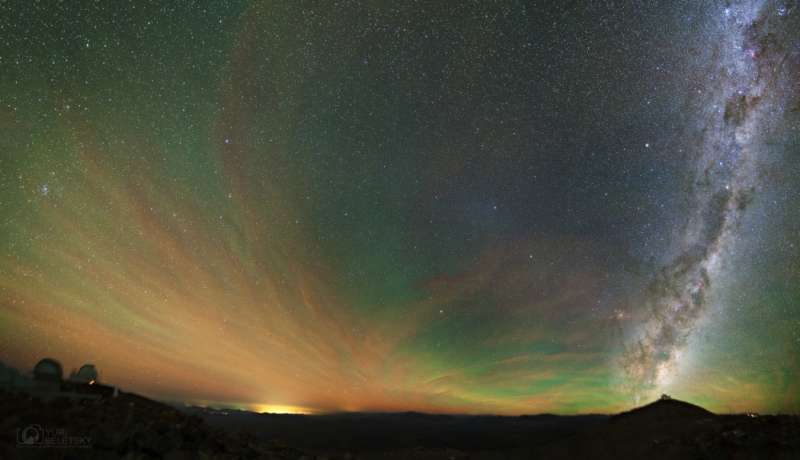Explanation: As far as the eye could see, it was a dark night at Las Campanas Observatory in the southern Atacama desert of Chile. But near local midnight on April 11, this mosaic of 3 minute long exposures revealed a green, unusually intense, atmospheric airglow stretching over thin clouds. Unlike aurorae powered by collisions with energetic charged particles and seen at high latitudes, the airglow is due to chemiluminescence, the production of light in a chemical reaction, and found around the globe. The chemical energy is provided by the Sun's extreme ultraviolet radiation. Like aurorae, the greenish hue of this airglow does originate at altitudes of 100 kilometers or so dominated by emission from excited oxygen atoms. The gegenschein, sunlight reflected by dust along the solar system's ecliptic plane was still visible on that night, a faint bluish cloud just right of picture center. At the far right, the Milky Way seems to rise from the mountain top perch of the Magellan telescopes. Left are the OGLE project and du Pont telescope domes.
1999 2000 2001 2002 2003 2004 2005 2006 2007 2008 2009 2010 2011 2012 2013 2014 2015 2016 2017 2018 2019 2020 2021 2022 2023 2024 2025 |
Январь Февраль Март Апрель Май Июнь Июль Август Сентябрь Октябрь Ноябрь Декабрь |
NASA Web Site Statements, Warnings, and Disclaimers
NASA Official: Jay Norris. Specific rights apply.
A service of: LHEA at NASA / GSFC
& Michigan Tech. U.
|
Публикации с ключевыми словами:
Противосияние - Млечный Путь
Публикации со словами: Противосияние - Млечный Путь | |
См. также:
Все публикации на ту же тему >> | |
